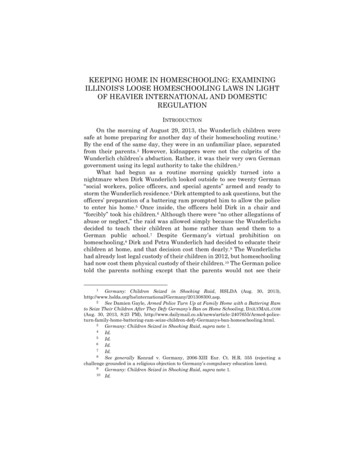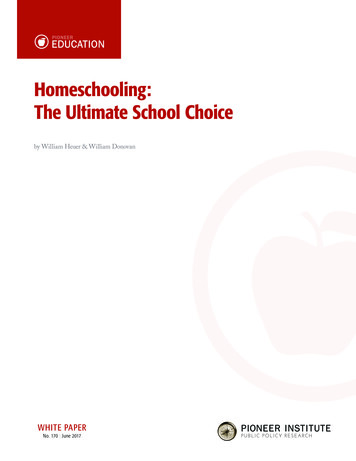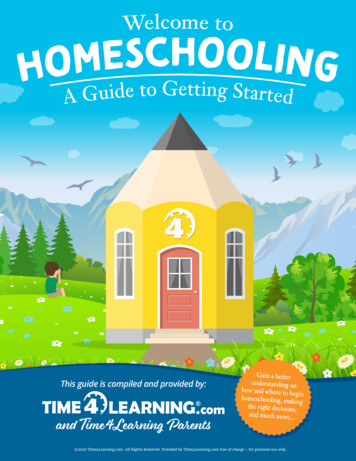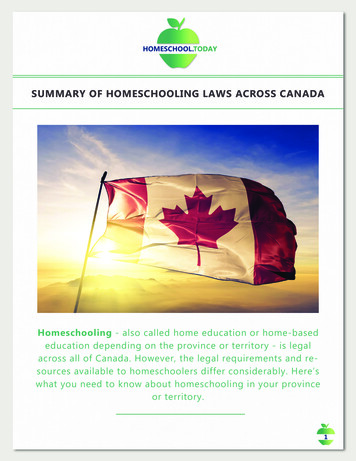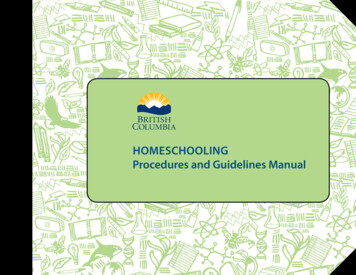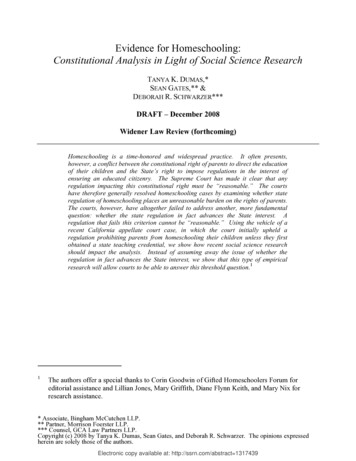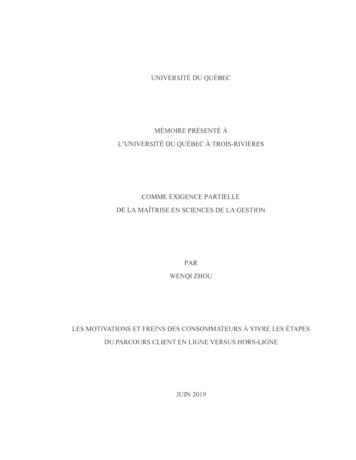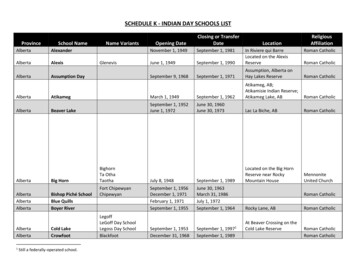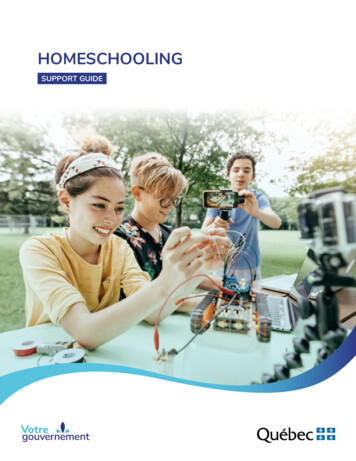
Transcription
HOMESCHOOLINGSUPPORT GUIDE
ACKNOWLEDGEMENTSThis guide was produced by the Direction de l’enseignement à lamaison (DEM) of the Ministère de l’Éducation et de l’Enseignementsupérieur. The DEM would like to thank all the individuals whocontributed to this document in one way or another, includingparent-educators and members of the education community, toonumerous to name here. This guide could not have been producedwithout their collaboration.
This document was produced by the Ministère de l’Éducation et de l’Enseignement supérieur.Title of original documentEnseignement à la maison – Guide d’accompagnementEnglish versionServices linguistiques en anglaisDirection du soutien au réseau éducatif anglophoneMinistère de l’Éducation et de l’Enseignement supérieurA PDF version of this document is available for download from the website ofthe Ministère de l’Éducation et de l’Enseignement supérieur at:www.education.gouv.qc.caFor additional information, contact:General informationMinistère de l’Éducation et de l’Enseignement supérieur1035, rue De La Chevrotière, 21e étageQuébec (Québec) G1R 5A5Telephone: 418-643-7095Toll-free: 1-866-747-6626Legal depositBibliothèque et Archives nationales du Québec, 2020Ministère de l’Éducation et de l’Enseignement supérieurISBN 978-2-550-85863-8 (print)ISBN 978-2-550-85864-5 (PDF) Gouvernement du Québec
TABLE OFCONTENTSINTRODUCTION . . . . . . . . . . . . . . . . . . . . . . . . . . . . . . . . . . . . . . . . . . . . . . . . . . . . . . . . . . . . . . . . . . . . . . . . . . . . . . . . . . . . . . . 51 FIRST AND FOREMOST. . . . . . . . . . . . . . . . . . . . . . . . . . . . . . . . . . . . . . . . . . . . . . . . . . . . . . . . . . . . . . . . . . . . . . . . . . . . . . . 72 DEVELOPMENT OF THE LEARNING PROJECT . . . . . . . . . . . . . . . . . . . . . . . . . . . . . . . . . . . . . . . . . . . . . . . . . . . . . . . . . . . 92.1 Québec Education Program. . . . . . . . . . . . . . . . . . . . . . . . . . . . . . . . . . . . . . . . . . . . . . . . . . . . . . . . . . . . . . . . . . . . . . . . . . . . . . . . . . 92.2 Literacy and numeracy. . . . . . . . . . . . . . . . . . . . . . . . . . . . . . . . . . . . . . . . . . . . . . . . . . . . . . . . . . . . . . . . . . . . . . . . . . . . . . . . . . . . . 102.3 Educational choices and planning of learning . . . . . . . . . . . . . . . . . . . . . . . . . . . . . . . . . . . . . . . . . . . . . . . . . . . . . . . . . . . . . . . . 132.4 Children with disabilities or difficulties. . . . . . . . . . . . . . . . . . . . . . . . . . . . . . . . . . . . . . . . . . . . . . . . . . . . . . . . . . . . . . . . . . . . . . 143 IMPLEMENTATION OF THE LEARNING PROJECT . . . . . . . . . . . . . . . . . . . . . . . . . . . . . . . . . . . . . . . . . . . . . . . . . . . . . . . 163.1 Learning anywhere, any time . . . . . . . . . . . . . . . . . . . . . . . . . . . . . . . . . . . . . . . . . . . . . . . . . . . . . . . . . . . . . . . . . . . . . . . . . . . . . . . 163.1.1 Learning spaces. . . . . . . . . . . . . . . . . . . . . . . . . . . . . . . . . . . . . . . . . . . . . . . . . . . . . . . . . . . . . . . . . . . . . . . . . . . . . . . . . . . . . 163.1.2 Time for learning. . . . . . . . . . . . . . . . . . . . . . . . . . . . . . . . . . . . . . . . . . . . . . . . . . . . . . . . . . . . . . . . . . . . . . . . . . . . . . . . . . . . . 163.2 Activating learning. . . . . . . . . . . . . . . . . . . . . . . . . . . . . . . . . . . . . . . . . . . . . . . . . . . . . . . . . . . . . . . . . . . . . . . . . . . . . . . . . . . . . . . . . 173.2.1 Learning opportunities. . . . . . . . . . . . . . . . . . . . . . . . . . . . . . . . . . . . . . . . . . . . . . . . . . . . . . . . . . . . . . . . . . . . . . . . . . . . . . . 173.2.2 Stimulating activities . . . . . . . . . . . . . . . . . . . . . . . . . . . . . . . . . . . . . . . . . . . . . . . . . . . . . . . . . . . . . . . . . . . . . . . . . . . . . . . . 183.2.3 Project-based learning. . . . . . . . . . . . . . . . . . . . . . . . . . . . . . . . . . . . . . . . . . . . . . . . . . . . . . . . . . . . . . . . . . . . . . . . . . . . . . . 193.2.4 Interdisciplinary approach. . . . . . . . . . . . . . . . . . . . . . . . . . . . . . . . . . . . . . . . . . . . . . . . . . . . . . . . . . . . . . . . . . . . . . . . . . . . 203.2.5 Motivation. . . . . . . . . . . . . . . . . . . . . . . . . . . . . . . . . . . . . . . . . . . . . . . . . . . . . . . . . . . . . . . . . . . . . . . . . . . . . . . . . . . . . . . . . . . 213.2.6 Parent-learners . . . . . . . . . . . . . . . . . . . . . . . . . . . . . . . . . . . . . . . . . . . . . . . . . . . . . . . . . . . . . . . . . . . . . . . . . . . . . . . . . . . . . 223.3 Using resources . . . . . . . . . . . . . . . . . . . . . . . . . . . . . . . . . . . . . . . . . . . . . . . . . . . . . . . . . . . . . . . . . . . . . . . . . . . . . . . . . . . . . . . . . . . 234 MONITORING THE CHILDREN’S LEARNING PROGRESS AND THE CERTIFICATION OF STUDIES . . . . . . . . . . . . . . 264.1 Evaluation for more effective learning. . . . . . . . . . . . . . . . . . . . . . . . . . . . . . . . . . . . . . . . . . . . . . . . . . . . . . . . . . . . . . . . . . . . . . . 264.1.1 Daily monitoring. . . . . . . . . . . . . . . . . . . . . . . . . . . . . . . . . . . . . . . . . . . . . . . . . . . . . . . . . . . . . . . . . . . . . . . . . . . . . . . . . . . . . 274.1.2 Status report and report on the child’s progress. . . . . . . . . . . . . . . . . . . . . . . . . . . . . . . . . . . . . . . . . . . . . . . . . . . . . . . . 284.1.3 Portfolio . . . . . . . . . . . . . . . . . . . . . . . . . . . . . . . . . . . . . . . . . . . . . . . . . . . . . . . . . . . . . . . . . . . . . . . . . . . . . . . . . . . . . . . . . . . . 294.2 Evaluation to provide qualifications . . . . . . . . . . . . . . . . . . . . . . . . . . . . . . . . . . . . . . . . . . . . . . . . . . . . . . . . . . . . . . . . . . . . . . . . . 314.2.1 Ministerial examinations . . . . . . . . . . . . . . . . . . . . . . . . . . . . . . . . . . . . . . . . . . . . . . . . . . . . . . . . . . . . . . . . . . . . . . . . . . . . . 314.2.2 Requirements for a Secondary School Diploma. . . . . . . . . . . . . . . . . . . . . . . . . . . . . . . . . . . . . . . . . . . . . . . . . . . . . . . . . 334.3 Education paths. . . . . . . . . . . . . . . . . . . . . . . . . . . . . . . . . . . . . . . . . . . . . . . . . . . . . . . . . . . . . . . . . . . . . . . . . . . . . . . . . . . . . . . . . . . 344.3.1 Possibility of studies in a school or a centre. . . . . . . . . . . . . . . . . . . . . . . . . . . . . . . . . . . . . . . . . . . . . . . . . . . . . . . . . . . . 345 COLLABORATION AMONG STAKEHOLDERS OF THE EDUCATION COMMUNITY. . . . . . . . . . . . . . . . . . . . . . . . . . . . . 355.1 The Ministère. . . . . . . . . . . . . . . . . . . . . . . . . . . . . . . . . . . . . . . . . . . . . . . . . . . . . . . . . . . . . . . . . . . . . . . . . . . . . . . . . . . . . . . . . . . . . . 355.2 School boards. . . . . . . . . . . . . . . . . . . . . . . . . . . . . . . . . . . . . . . . . . . . . . . . . . . . . . . . . . . . . . . . . . . . . . . . . . . . . . . . . . . . . . . . . . . . . 35
5.2.1 Resources and services . . . . . . . . . . . . . . . . . . . . . . . . . . . . . . . . . . . . . . . . . . . . . . . . . . . . . . . . . . . . . . . . . . . . . . . . . . . . . . 365.2.2 Evaluation. . . . . . . . . . . . . . . . . . . . . . . . . . . . . . . . . . . . . . . . . . . . . . . . . . . . . . . . . . . . . . . . . . . . . . . . . . . . . . . . . . . . . . . . . . . 375.2.3 Transition. . . . . . . . . . . . . . . . . . . . . . . . . . . . . . . . . . . . . . . . . . . . . . . . . . . . . . . . . . . . . . . . . . . . . . . . . . . . . . . . . . . . . . . . . . . 385.3 Working together and helping each other. . . . . . . . . . . . . . . . . . . . . . . . . . . . . . . . . . . . . . . . . . . . . . . . . . . . . . . . . . . . . . . . . . . . 385.3.1 Education Community. . . . . . . . . . . . . . . . . . . . . . . . . . . . . . . . . . . . . . . . . . . . . . . . . . . . . . . . . . . . . . . . . . . . . . . . . . . . . . . . 395.3.2 Organizations . . . . . . . . . . . . . . . . . . . . . . . . . . . . . . . . . . . . . . . . . . . . . . . . . . . . . . . . . . . . . . . . . . . . . . . . . . . . . . . . . . . . . . . 40CONCLUSION . . . . . . . . . . . . . . . . . . . . . . . . . . . . . . . . . . . . . . . . . . . . . . . . . . . . . . . . . . . . . . . . . . . . . . . . . . . . . . . . . . . . . . . . 41Homeschooling calendarREFERENCES . . . . . . . . . . . . . . . . . . . . . . . . . . . . . . . . . . . . . . . . . . . . . . . . . . . . . . . . . . . . . . . . . . . . . . . . . . . . . . . . . . . . . . . . 42
INTRODUCTIONIn Québec, any child who receives appropriate homeschooling is exempt from compulsory school attendance,provided the homeschooling complies with the legal framework. This framework aims to ensure thathomeschooling contributes to the development of a child’s full potential, educational success and qualificationin preparation for admission to higher education or integration into the job market. Homeschooling must thusallow the child to have access to high-quality learning.This guide is designed primarily to advise and support parents who wish to provide homeschooling or arealready in the process of doing so. It is also intended for school boards and other stakeholders in the educationcommunity. It provides answers to questions raised by this educational model and allows everyone involved tomake a positive contribution.1This guide also deals with the pedagogical, organizational and collaborative practices that contribute to theeducational success of children in a family environment. These best practices2 refer, on the one hand, to thedevelopment and implementation of the learning project and, on the other, to the monitoring and evaluationof the children’s learning progress and the collaboration among the various stakeholders. The roles andresponsibilities of these stakeholders are defined, and a calendar of the major steps to be completed is given inthe conclusion.In addition to this guide, tools have been developed to support parent-educators in complying with their legalobligations. These tools are templates that may be used to prepare the learning project, the status reports andthe reports on the child’s progress. They can be found on the Ministère’s website.12This guide aims to provide support for homeschooling. Further details can be found in the Education Act and applicable regulations.The list of best practices referred to in this guide is not exhaustive. Moreover, their effectiveness and relevance depend on the context, the children, theirfamilies, and their needs and preferences.HOMESCHOOLINGISUPPORT GUIDE5
1 FIRST AND FOREMOSTThe roles and responsibilities of the various education partners, including the Ministère de l’Éducation et del’Enseignement supérieur, the school boards and the parent-educators, aim to ensure that all children are giventhe opportunity to succeed, whatever their needs may be.RESPONSIBILITIES OF PARENT-EDUCATORSThe parent-educators send a notice to the Minister and their school board. They work with their child on developinga learning project, which they submit to the Minister in accordance with the requirements and deadlines specifiedin the legal framework. They attach any documents or information relevant to the examination of this project. Theyimplement the learning project, prepare a status report and participate in a follow-up meeting with their childand the Ministère’s resource person. Additional meetings may be necessary if the parents are having difficultyimplementing the learning project or if the child is not making adequate progress. The parent-educators monitortheir child’s progress using one or more evaluation methods and submit a mid-term report to the Minister as wellas a completion report. In addition, they ensure that their child will take any ministerial examinations imposedunder the Homeschooling Regulation. In order to allow for the evaluation required for the granting of a diplomarecognized by the Minister, they send a copy of their child’s learning project to their school board. This sameprocedure is followed whenever the parent-educators apply for access to textbooks, instructional materials orcomplementary services. Lastly, the responsibility of the child’s learning project rests primarily with the parenteducators, who are also the main contact for any homeschooling-related communications with the Ministère.ROLE OF THE MINISTÈRE DE L’ÉDUCATION ET DE L’ENSEIGNEMENT SUPÉRIEURThe Ministère provides ongoing monitoring of families’ homeschooling and supports families by examining thechildren’s learning projects and assisting parent-educators who are having difficulty developing or implementingthe learning projects. The Direction de l’enseignement à la maison (DEM) was created for this purpose and acts inan advisory capacity, particularly with respect to the activities, pedagogical resources and ministerial programsof study. It monitors the children’s progress, examines the reports, and makes recommendations or providesinformation on ministerial examinations and the certification of studies, for example. Finally, it evaluates thelearning progress of children whose parent-educators have submitted a portfolio to the Minister.ROLE AND RESPONSIBILITIES OF THE MINISTÈREFurther information on the Ministère’s role and responsibilities with regard to homeschooling can be found GISUPPORT GUIDE7
SUPPORT OFFERED BY SCHOOL BOARDSOn the conditions determined by each school board, and at the request of the parent-educators, school boardsprovide homeschooled children with access, free of charge, to the following: textbooks that are approved by the school principals and required for teaching instructional material that is offered free of charge, approved by the school principals and required forteaching, subject to their availability certain complementary student services, subject to their availability and the needs of the child certain resources and the equipment required for using them in at least one of their schools, subject toavailabilityTo assess the learning progress of homeschooled children, the school board that has jurisdiction conducts anevaluation of learning in accordance with the procedures it determines. When required under the HomeschoolingRegulation, the school board must take the necessary measures to provide homeschooled children with access,in one of the school board’s rooms and at no charge, to the examination imposed by the school board or theMinister as well as to any preparatory activities. The school board must also take the necessary measures topermit the children to be evaluated, free of charge, in order to obtain the credits they need to earn a diplomarecognized by the Minister, without having taken the corresponding course, provided the pedagogical andorganizational requirements are met.8
2 DEVELOPMENT OFTHE LEARNING PROJECT2.1 QUÉBEC EDUCATION PROGRAMTo ensure the quality of the children’s educational experience and of instruction aimed at developing competenciesand acquiring knowledge, the Homeschooling Regulation3 stipulates that the development and implementation ofa learning project must comply with the programs of study established by the Minister.The mission of education in Québec is threefold: to provide instruction, to socialize and to provide qualifications.This mission is essentially embodied in the Québec Education Program (QEP), which constitutes a frame ofreference for all school and community stakeholders. The QEP serves as a tool for teachers and as a key referencefor the school administration, staff, members of the governing board and parents, including parent-educators.Its implementation is based, among other things, on the concept of competency, which is defined as “a set ofbehaviours based on the effective mobilization and use of a range of resources.”4 It also focuses on the acquisitionof a body of knowledge, constructed on the basis of various subjects and competencies spread over three cyclesin elementary school, and two cycles in secondary school. Learning to take effective action implies that childrenintegrate knowledge and skills harmoniously.34Homeschooling Regulation, CQLR, c. I-13.3, r. 6.01, s. 4.Québec, Ministère de l’Éducation, Québec Education Program, Preschool Education; Elementary Education (Québec, 2001), section 1.4, 4.HOMESCHOOLINGISUPPORT GUIDE9
The primary components of the QEP are general in scope, namely the cross-curricular competencies andthe broad areas of learning. The cross-curricular competencies are composed of transferable learning thatis intellectual, methodological, personal or social, and communication-related in nature. The broad areas oflearning deal with aspects of contemporary life and issues that young people face, individually or collectively, indifferent spheres of life. The broad areas are health and well-being, personal and career planning, environmentalawareness and consumer rights and responsibilities, media literacy, as well as citizenship and community life.Within the broad areas of learning, the Minister also prescribes the following learning content: Sexuality Education content for each year of elementary and secondary school5 Academic and Career Guidance content for Elementary Cycle Three and Secondary Cycle One6 a cardiopulmonary resuscitation (CPR) training activity for Secondary III students7In a homeschooling context, the parent-educators can choose to include this content in the learning project.The programs of study correspond to the subjects in the QEP, which are associated with subject-specificcompetencies and specific content. These official pedagogical documents define the essential learning, in astructured format, for providing instruction, socializing and providing qualifications for students and childrenover a set period of time.The Progression of Learning complements each program of study and provides details about the essential knowledgethat must be acquired and applied every year in each subject. Schools and parent-educators use this document toassist them in planning both their teaching and the learning that their students and children are to acquire.2.2 LITERACY AND NUMERACYLiteracy and numeracy skills are widely acknowledged for their valuable contribution to constructing anindividual’s future. These competencies go beyond reading, writing and arithmetic. They also encompass theability to use information and access knowledge by means of a variety of materials and digital media andmake it possible to make informed decisions in a variety of contexts.Literacy is founded on the ability to read, write and express oneself orally. The Réseau québécois de rechercheet de transfert en littératie defines literacy as:. . . the ability of an individual or a community to communicate information through language presented invarious forms in order to participate actively in society in different contexts [translation].8Competencies in this area are indispensable, since language acquisition is not simply a question of studyinggrammar and spelling. Indeed, language provides access to learning in all areas and promotes participation insociety and openness to the world. Literacy also contributes to creating personal relationships that enrich thequality of each individual’s guidance-contentA ministerial allocation makes it possible for all schools to offer cardiopulmonary resuscitation (CPR) training to all Secondary III students.Nathalie Lacelle, Lizanne Lafontaine, André C. Moreau and Raika Laroui, “Définition de la littératie,” Réseau québécois de recherche et de transfert enlittératie (Centre de transfert pour la réussite éducative du Québec, 2016).
Frequent family literacy activities in childhood are also known to foster motivation and educational success.9Parents are examples of readers and writers who greatly influence the development of their children’s literacy skills.SOME ACTIVITIES AND PROJECTS THAT ARE PARTICULARLY USEFUL IN DEVELOPINGCHILDREN’S LITERACY SKILLS: Present projects to people within or outside the family circle. Conduct interviews with family or education community members. Share family stories. Read about current events and discuss social issues, bearing in mind the children’s age and interests. Make regular visits to the library or do volunteer work there. Do the research required to plan a trip. Read aloud with family members (parents and children or children among themselves). Form a family reading club or join one with other families. Use online collaborative editing. Use digital writing tools to improve written productions. Use a notebook to express ideas in free-form writing. Participate in writing competitions. Create a comic strip or graphic novel, perhaps using software designed for this purpose. Create a board game. Produce a video and publish it online. Participate in collaborative writing. Draw up lists (e.g. groceries, things to do, ideas). Write a personal diary. Write a family diary. Correspond with a pen pal. Keep a blog. Use notebooking.10 Keep a nature lecture.pdf (available in French only)Producing a document in which notes on a subject, comments, drawings, photos or other visual components are recorded.HOMESCHOOLINGISUPPORT GUIDE11
NUMERACY IS DEFINED AS:. . . the ability to access, use, interpret and communicate mathematical information and ideas in order toengage in and manage the mathematical demands of a range of situations in adult life. To this end, numeracyinvolves managing a situation or solving a problem in a real context, by responding to mathematical content/information/ideas represented in multiple ways.11Numeracy encompasses all of the mathematical knowledge and skills that enable an individual to participateactively in society, making it a goal for young people, whatever their profile.12 Children build a set of tools tosolve situational problems. They learn to communicate appropriately using mathematical language and reasoneffectively by making connections between mathematical concepts and processes and everyday situations.SOME ACTIVITIES THAT ARE PARTICULARLY USEFUL IN DEVELOPING CHILDREN’SNUMERACY SKILLS: Plan and make purchases. Manage a building project. Estimate and measure the dimensions, area, volume or mass of different objects using conventionaland unconventional units. Count collections of objects. Measure distances covered when travelling. Participate in budget planning or do the accounts. Estimate and measure time (e.g. number of days before an activity, length of an activity in hours orminutes). Compare the quantities or sizes of objects. Follow instructions to do crafts (e.g. include geometrical shapes). Draw an object to scale. Conduct a survey and share the results. Use virtual or augmented reality to measure angles or distances. Produce the plan of a room or an outside area. Read books that refer to mathematical concepts. Convert units of measure to follow a recipe or carry out a renovation project. Make clothes (e.g. knitting, sewing). Introduce programming to children using robots that move over an image map. Participate in a family business.111212Organisation for Economic Co-operation and Development (OECD), Skills Outlook 2013; First Results From the Survey of Adult Skills (OECD Publishing,2013), 59.Québec, Ministère de l’Éducation, du Loisir et du Sport, Progression of Learning in Elementary School; Mathematics (Québec, 2009), 3.
In addition to the development of literacy and numeracy skills, digital skills are essential for learning andprogressing in the 21st century. Digital competency is described as:. . . a set of skills necessary to the confident, critical and creative use of digital technologies to achieveobjectives with regard to learning, work, leisure, and inclusion or participation in society.132.3 EDUCATIONAL CHOICES AND PLANNINGOF LEARNINGThere are a large number of educational approaches that may be used in a homeschooling context. Flexibility mustbe kept in mind when selecting these approaches so they can be adapted over time and to the children’s needs.The learning project is, above all, a planning tool and a starting point for monitoring a child’s progress. It deals withthe parent-educators’ educational choices regarding the planned learning and the activities and resources thatwill be used to acquire it.The learning project identifies the educational aims and objectives for acquiring knowledge and developingcompetencies. These aims and objectives refer to what the children are expected to know and be able to do at theend of a set period of time. Children should know and understand these aims as well as the criteria for success.Indeed, children benefit from being included in discussions that concern planning the learning project and choosingresources and learning activities.The planning process involves choosing specific activities and projects that are in keeping with the learning aims,and deciding on ways to evaluate the children’s progress.14It is impossible for a learning project to describe all the learning to be acquired and all the activities planned.However, it is important to ensure that the activities are varied and stimulating and that they will enable the childrento acquire knowledge and develop basic skills. The Homeschooling Regulation provides for the application of theprograms of study established by the Minister in the following subjects: a subject in the language of instructionand a subject in the second language, depending on the parents’ choice, one in French and the other in English;and the compulsory subjects in the subject areas of Mathematics, Science and Technology, and Social Sciences.The subjects are chosen from those that would be offered in the cycle of education that the child would be in ifattending school. The same progression of learning must be applied as that at school. However, no time frame forteaching subject-specific content is established within the cycle.A child’s learning project may include knowledge and competencies other than those provided for by the QEP.For example, some elements of learning complete and enrich a child’s existing knowledge (e.g. sign language oranother language, babysitting, wilderness orientation, crafts, horticulture, mechanics, farming).1314Québec, Ministère de l’Éducation et de l’Enseignement supérieur, Digital Competency Framework (2019), 7.Grant Wiggins and Jay McTighe, Understanding by Design, Expanded 2nd edition (Alexandria, Virginia: Association for Supervision and Curriculum Development, 2005).HOMESCHOOLINGISUPPORT GUIDE13
A separate learning project must be prepared for each child in the same family. Learning projects are inevitablydifferent from one another and call for differentiated strategies and methods. Personalizing a learning projectmeans taking into account to a greater extent each child’s individual needs, abilities, skills, learning pace, interestsand ambitions.Obviously, core curriculum subjects can be learned through identical activities carried out by children of differentages in the same family. However, the preparation, materials, tools or other resources may be different or adaptedfor each child. It may also be necessary to provide feedback individually when the learning outcomes, reactions orchallenges are different for each child.Under the Homeschooling Regulation, a child’s learning project must include the following elements: a description of the chosen educational approachthe targeted programs of study and a brief description of the associated activities chosenthe other subjects that will be taught and a brief description of the activities chosen for that purposethe other knowledge and skills that the child is expected to acquire, as well as a brief description of therelevant teaching and learning activities chosenthe educational resources that will be useda plan indicating the approximate amount of time that will be allocated to learning activitiesthe name and contact information of each organization that will contribute to the child’s learning, as well asa description of the organization’s contribution, which must include the type (e.g. online course, workshop,tutoring) and scale (e.g. personalized or group activities) of the contributionthe evaluation methods that will be used to assess the child’s progressthe last level of educational services that the child received in an educational institution2.4 CHILDREN WITH DISABILITIES OR DIFFICULTIESIt is in the interests of children to maintain high expectations regarding their learning and to present stimulatingchallenges that will help them discover their aptitudes and enable them to persevere in finding solutions thatguarantee success. It is not always
provided the homeschooling complies with the legal framework. This framework aims to ensure that homeschooling contributes to the development of a child's full potential, educational success and qualification in preparation for admission to higher education or integration into the job market. Homeschooling must thus
